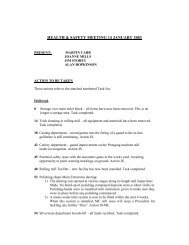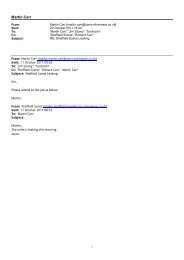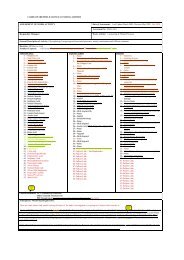Degreasing Operations - Carrs of Sheffield Health and Safety ...
Degreasing Operations - Carrs of Sheffield Health and Safety ...
Degreasing Operations - Carrs of Sheffield Health and Safety ...
Create successful ePaper yourself
Turn your PDF publications into a flip-book with our unique Google optimized e-Paper software.
Report Date : 24/08/2011 3 / 6<br />
SECTION 6: ACCIDENTAL RELEASE MEASURES<br />
EVOLVE CH10<br />
Revision 2<br />
6.1. Personal precautions, protective equipment <strong>and</strong> emergency procedures<br />
Wear protective clothing as described in Section 8 <strong>of</strong> this safety data sheet. Ensure suitable personal protection (including respiratory<br />
protection) during removal <strong>of</strong> spillages in a confined area. In case <strong>of</strong> inadequate ventilation, use respiratory protection. Take precautionary<br />
measures against static discharges. Do not smoke, use open fire or other sources <strong>of</strong> ignition. Do not breathe vapour. Eye contact MUST<br />
be prevented by means <strong>of</strong> suitable personal protection equipment.<br />
6.2. Environmental precautions<br />
Do not discharge onto the ground or into water courses. Do not allow ANY environmental contamination. Never use water by itself on<br />
spillage; this will spread the spill <strong>and</strong> cause further contamination.<br />
6.3. Methods <strong>and</strong> material for containment <strong>and</strong> cleaning up<br />
If leakage cannot be stopped, evacuate area. Clean-up personnel should use respiratory <strong>and</strong>/or liquid contact protection. Wash<br />
thoroughly after dealing with a spillage. Extinguish all ignition sources. Avoid sparks, flames, heat <strong>and</strong> smoking. Ventilate. Absorb spillage<br />
with non-combustible, absorbent material. Cover large spillage with alcohol-resistant foam. Dam <strong>and</strong> absorb spillage with s<strong>and</strong>, earth or<br />
other non-combustible material. Run<strong>of</strong>f or release to sewer, waterway or ground is forbidden. Inform Authorities if large amounts are<br />
involved. Spillage may be stored as chemical waste in approved area.<br />
6.4. Reference to other sections<br />
SECTION 7: HANDLING AND STORAGE<br />
7.1. Precautions for safe h<strong>and</strong>ling<br />
Avoid spilling, skin <strong>and</strong> eye contact. Keep away from heat, sparks <strong>and</strong> open flame. Eliminate all sources <strong>of</strong> ignition. Static electricity <strong>and</strong><br />
formation <strong>of</strong> sparks must be prevented. Storage tanks <strong>and</strong> other containers must be grounded. Protect electric equipment against<br />
sparking in case <strong>of</strong> risk <strong>of</strong> explosion. Wear full protective clothing for prolonged exposure <strong>and</strong>/or high concentrations. Contaminated rags<br />
<strong>and</strong> cloths must be put in firepro<strong>of</strong> containers for disposal. Do not eat, drink or smoke when using the product. Container must be kept<br />
tightly closed.<br />
7.2. Conditions for safe storage, including any incompatibilities<br />
Keep away from heat, sparks <strong>and</strong> open flame. Keep containers tightly closed. Keep away from food, drink <strong>and</strong> animal feeding stuffs.<br />
Avoid contact with oxidising agents. Flammable/combustible - Keep away from oxidisers, heat <strong>and</strong> flames. Ground container <strong>and</strong> transfer<br />
equipment to eliminate static electric sparks. Keep in original container.<br />
Storage Class<br />
Miscellaneous hazardous material storage.<br />
7.3. Specific end use(s)<br />
Usage Description<br />
The information contained within this <strong>Safety</strong> Data Sheet is given as a guide to the precautions required to maintain a safe work<br />
environment. Storage tanks must be positioned within a bunded area.<br />
SECTION 8: EXPOSURE CONTROLS/PERSONAL PROTECTION<br />
8.1. Control parameters<br />
Name<br />
STD<br />
TWA - 8 Hrs<br />
STEL - 15 Min<br />
Notes<br />
ISOPARAFFINIC HYDROCARBON<br />
WEL<br />
1200 mg/m3<br />
WEL = Workplace Exposure Limit.<br />
8.2. Exposure controls<br />
Protective equipment<br />
Process conditions<br />
Use engineering controls to reduce air contamination to permissible exposure level. Provide eyewash, quick drench.<br />
Engineering measures<br />
Provide adequate ventilation, including appropriate local extraction, to ensure that the defined occupational exposure limit is not<br />
exceeded. Explosion-pro<strong>of</strong> general <strong>and</strong> local exhaust ventilation.<br />
Respiratory equipment<br />
If ventilation is insufficient, suitable respiratory protection must be provided. At work in confined or poorly ventilated spaces, respiratory<br />
protection with air supply must be used. Check that mask fits tight <strong>and</strong> change filter regularly.








